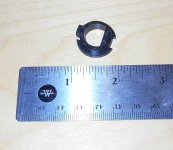clh333
Veteran Member
Our friends at FedEx delivered a Panasonic KXP 1592 printer recently that had enjoyed their signature treatment: Several internal plastic pieces had broken. The most serious casualty was a bushing that served to orient the print-head carrier. The steel rod the head travels across sits in a bushing that prevents the rod from rotating freely but allows adjustment of the head spacing gap. One of the two bushings (one on either side) was obliterated.
Fortunately the other one is in tact. I haven't found any donor machines or parts suppliers for this model so I am beginning to think I might have the survivor copied and 3-D printed. I know nothing about this topic: the few pieces I have had made were crude and fragile and ultimately failed. I suppose casting is another method but I know equally little and it seems like a difficult thing to pull off.
And so I am posting to ask for guidance on getting this part duplicated. Also: There was a discussion of the best cement to use for plastic repair. I can't find that post but Chuck(G) had a recommendation...?
Thanks for your suggestions.
-CH-

Fortunately the other one is in tact. I haven't found any donor machines or parts suppliers for this model so I am beginning to think I might have the survivor copied and 3-D printed. I know nothing about this topic: the few pieces I have had made were crude and fragile and ultimately failed. I suppose casting is another method but I know equally little and it seems like a difficult thing to pull off.
And so I am posting to ask for guidance on getting this part duplicated. Also: There was a discussion of the best cement to use for plastic repair. I can't find that post but Chuck(G) had a recommendation...?
Thanks for your suggestions.
-CH-

